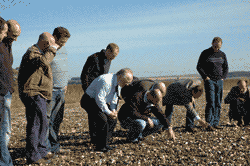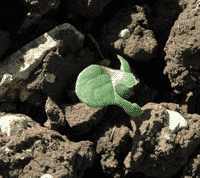Sigma Team meeting: Backward OSR can still perform well
Don’t give up too soon on seemingly struggling rape crops was the underlying message from last week’s second meeting of the Sigma Oilseed Rape Professional Growers Team in Yorkshire. Andrew Blake reports
Given proper care and attention, the often backward crops from this autumn’s later sowings should pull through to help offset lower output from reduced sowings.
 |
|---|
| So where is it all? Sigma team members check for signs of OSR emergence in NIAB trial plots at Clifford Spencer’s farm near Driffield, Yorkshire. |
But growers will need to be even more alert to potential problems and be prepared to check the unusually small plants more often for diseases and pests, especially slugs.
NK Seeds’ Nigel Padbury estimated that the 2008/09 UK crop area would be 12-15% down on last season’s because of difficult sowing conditions.
“I think we’re looking at a total of 520,000-540,000ha, which is a fall of about 80,000 on last year,” he said.
Until the intensive drilling window that opened around mid-September, Mr Padbury had expected the area to be down by as much as 25%.
Growers increasingly accepted that hybrids, with their extra vigour, were more suited to later sowing, he said. That meant the hybrid area share would rise significantly from last year’s 22%. “It’s anything from 33% to 48% depending on who you talk to.”
Between them, conventional Castille and hybrid Excalibur accounted for about 40% of sowings, the rest being shared by 33 varieties, only three taking 5% or more, he said. “In 1980 we had just three varieties – now the list is enormous.”
|
|---|
None of the firm’s replicated trials – of 20 varieties on eight sites from Hampshire to Perth and Cork in Ireland – had been sown before the first week in September, he noted.
“They were at least three weeks late, and, given the season’s difficulties, the fact that we got them in at all is very pleasing.”
Mr Padbury said he was surprised how many growers had said they had as few as 10 plants a square metre and had decided to plough out crops – prematurely, in his view.
“When I hear that, I say please leave it until the spring. Very often the best crops are those that look abysmal in the autumn.”
Autumn N easily justified
Oilseed rape growing is all about creating the correct crop structure to support seed production, but the number and size of those seeds is not determined until mid-flowering, ADAS’s John Spink reminded the meeting.
Stressing that August-sown crops often achieved over-dense canopies that then need extra-careful spring manipulation, he gave details of four years of ADAS trials in the late 1990s that compared crops sown at high and low seed rates at the end of August and the end of September.
Apart from one year when the late-sown crop went through winter with only one leaf and never caught up, output was much the same.
“So essentially there was no difference between early and late drilling,” he said.
Indeed, mowing crops to within an inch of the ground just before Christmas, to simulate uniform pigeon grazing, raised yields in all cases except the low seed rate sown late.
Most of this autumn’s crops were sown late and the plants were small, Mr Spink acknowledged. “But you’ve still got a lot of time to put it right and have high seed potential.”
A key factor was early nutrition, he said.
“Compared with other seasons, we’ve got low nitrogen residues in the surface. Wheat yields were good and after the high summer rainfall, there’s very little N left. So small plants with only a couple of inches of roots won’t be able to get hold of any N.”
In those circumstances, an autumn dressing of 25-30kg/ha of N was easily justified. “It’s definitely the right thing to do.”
Given the predominance of backward crops, there would be less need for growth regulatory-type fungicides to control canopies, although much depended on over-winter growth.
Come the spring, it would be worth checking crops below ground, he advised. ADAS work showed better rooting could lift yields by 0.6t/ha (5cwt/acre). “And one of the most consistent ways of improving rooting is the use of metconazole as a PGR.”
Downy mildew threat
Downy mildew is the disease of most immediate concern to late-sown, backward and slow-growing crops, the meeting heard.
Crops at the cotyledon to one-leaf stage were especially vulnerable.
“Once the crop has three to four leaves, it grows away from it,” said ADAS’s Peter Gladders.
With Fubol (mancozeb + metalaxyl) no longer approved on the crop, control had become much trickier. “Fubol was very efficient,” he added.
The current options, mancozeb (alone) and chlorothalonil, protected young plants but didn’t cure the disease, he pointed out.
“The other thing is that spraying is very inefficient because you’re hitting mostly the ground when the plants are so small.”
Cruiser (thiamethoxam), as yet available only on imported seed, did seem to be offering useful downy mildew control in some Scottish crops, said Mr Padbury.
Soil test offer
All growers at the meeting were given the chance to use GrowHow’s N-Min soil-testing service free on a couple of their fields.
By assessing N reserves in the top 30cm of their soil, the firm could then use test data from 240 sites to predict how much extra N would become available from down to 90cm, said Tom Land.
It was becoming increasingly important to use such information to guide fertiliser applications, especially for growers in NVZs, he said.
Grower views
Having sown 174ha (430 acres) of rape at least two weeks later than usual, Derbyshire grower James Chamberlain’s main concern was an early onset of cold weather.
Pigeons, a “huge problem” last autumn, could be even more devastating on this year’s small plants, he said.
 |
|---|
| Slug damage, as elsewhere, was quite readily found at Clifford Spencer’s farm |
Less than half his crop, on which he planned to apply 25kg/ha of N, had emerged. “We didn’t start drilling until 18 September.”
On the plus side, all the land had been ploughed, which should encourage rooting, he said. “It’s a lazy crop and that should help if the temperature drops.”
Philip Smith from Aberdeenshire said most growers in his area had planned to double their rape area. But bad weather meant the increase had been only 20-25%. Early sowings had emerged within a week, but later ones were taking two.
“Soil conditions are still saturated and have been for six to eight weeks now.”
But with light leaf spot pressure high, Mr Smith expected to apply a fungicide treatment in about four weeks. “I have no intention of scrimping on inputs.”
Keith Challen, from Nottinghamshire, still had nearly one-third of his 810ha (2000 acres) of rape, all min-tilled, at the cotyledon stage.
“We’ve had some embarrassing seed-beds, though we’ve still got respectable plant populations,” he said. But heavy slug pellet applications had been needed, he admitted.
After post-emergence Springbok (dimethenamid-P and metazachlor) hit his crop badly two years ago, he was confining the product to pre-em treatments.

Sigma members:
- ADAS
- Farmers Weekly
- GrowHow NK
- Syngenta Seeds
- Farmers UK-wide

